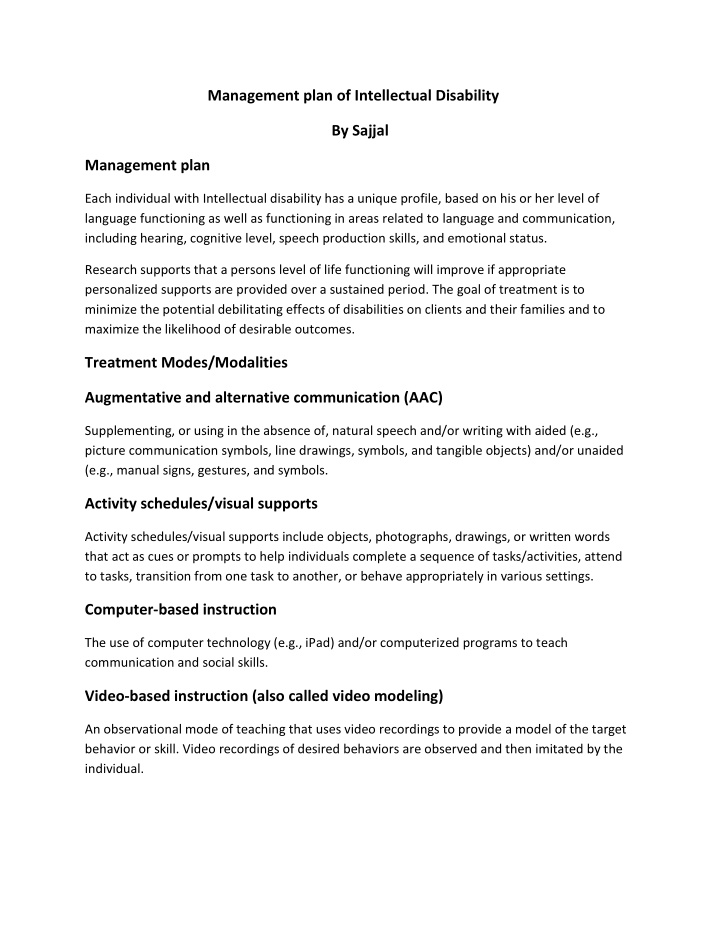



Management plan of Intellectual Disability By Sajjal Management plan Each individual with Intellectual disability has a unique profile, based on his or her level of language functioning as well as functioning in areas related to language and communication, including hearing, cognitive level, speech production skills, and emotional status. Research supports that a persons level of life functioning will improve if appropriate personalized supports are provided over a sustained period. The goal of treatment is to minimize the potential debilitating effects of disabilities on clients and their families and to maximize the likelihood of desirable outcomes. Treatment Modes/Modalities Augmentative and alternative communication (AAC) Supplementing, or using in the absence of, natural speech and/or writing with aided (e.g., picture communication symbols, line drawings, symbols, and tangible objects) and/or unaided (e.g., manual signs, gestures, and symbols. Activity schedules/visual supports Activity schedules/visual supports include objects, photographs, drawings, or written words that act as cues or prompts to help individuals complete a sequence of tasks/activities, attend to tasks, transition from one task to another, or behave appropriately in various settings. Computer-based instruction The use of computer technology (e.g., iPad) and/or computerized programs to teach communication and social skills. Video-based instruction (also called video modeling) An observational mode of teaching that uses video recordings to provide a model of the target behavior or skill. Video recordings of desired behaviors are observed and then imitated by the individual.
Behavioral interventions and techniques (e.g., different reinforcement, prompting, fading, and modeling) are designed to reduce problem behaviors and teach functional alternative behaviors using the basic principles of behavior change. Applied behavior analysis (ABA) ABA techniques have been used to help build a variety of skills (e.g., communication, social skills, self-control, and self-monitoring) and help generalize these skills to other situations. The techniques can be used in both structured (e.g., classroom) and everyday (e.g., family dinnertime) settings and in one-on-one or group instruction. ABA has been used for individuals with ID. Functional communication training (FCT) FCT approach has been used with students with ID to replace challenging behaviors with appropriate communication alternatives. Various therapeutic services can improve a person's adaptive behavioral skills. These therapies are helpful for many people with intellectual disabilities (ID, formerly mental retardation). Occupational therapy Meaningful and purposeful activities; Self-care (e.g., grooming, dressing, feeding, bathing); Employment activities and skills; Leisure activities (e.g., knitting, playing games); Domestic activities (e.g., cooking, cleaning, laundry). Speech therapy Improves communication skills; Improves receptive and expressive languages skills; Improves speech articulation; Improves vocabulary. Physical therapy Enhances quality of life by maximizing mobility and self-locomotion;
Provides adaptive solutions to mobility problems; Increases sensory integration Family support Special education Play therapy Play therapy has been suggested for several decades as an intervention to help children with IDs strengthen adaptive behaviors and develop stronger social relationships . Individualized Family Services Plan (IFSP), which outlines the needs of the child and the services that child should receive. Once the child reaches school age, an Individualized Education Plan (IEP ) will be developed by school staff and the parents of the child. References https://www.mentalhelp.net/articles/therapies-for-intellectual-disabilities-and-outdated- unproven-treatments/ American Association on Intellectual and Developmental Disabilities. (2013). Definition of intellectual disability. Retrieved from www.aaidd.org American Psychiatric Association. (2013). Diagnostic and statistical manual of mental disorders (5th ed.). Washington, DC: Author. American Speech-Language-Hearing Association. (2004). Preferred practice patterns for the profession of speech-language pathology [Preferred Practice Patterns]. Available from www.asha.org/policy American Speech-Language-Hearing Association. (2016a). Code of ethics [Ethics]. Available from www.asha.org/policy American Speech-Language-Hearing Association. (2016b). Scope of practice in speech-language pathology. [Scope of Practice]. Available from www.asha.org/policy Batshaw, M. L., Roizen, N. J., & Lotrecchiano, G. R. (2013). Children with disabilities: A medical primer (7th ed.). Baltimore, MD: Brookes.
Beukelman, D. R, & Mirenda, P. (2013). Augmentative and alternative communication: Supporting children and adults with complex communication needs. Baltimore, MD: Brookes. Brady, N. C., Bruce, S., Goldman, A., Erickson, K., Mineo, B., Ogletree, B. T., . . . Wilkinson, K. (2016). Communication services and supports for individuals with severe disabilities: Guidance for assessment and intervention. American Journal on Intellectual and Developmental Disabilities, 121, 121 – 138.
Recommend
More recommend